Modular: Resurrecting RuneQuest: An Investigation by the Tales of the Reaching Moon Editorial Staff
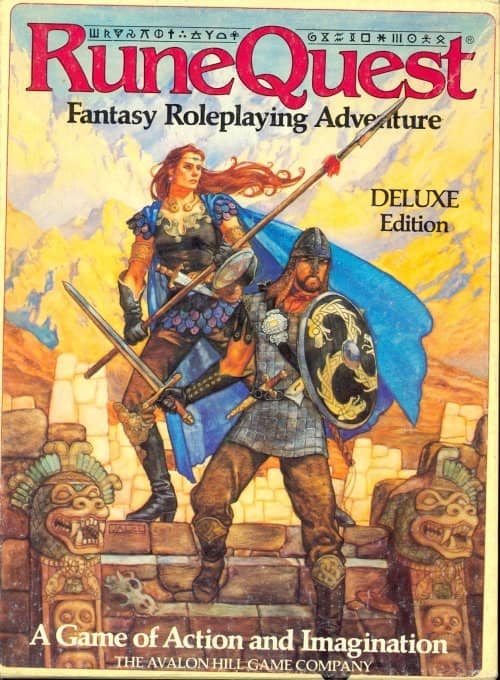 |
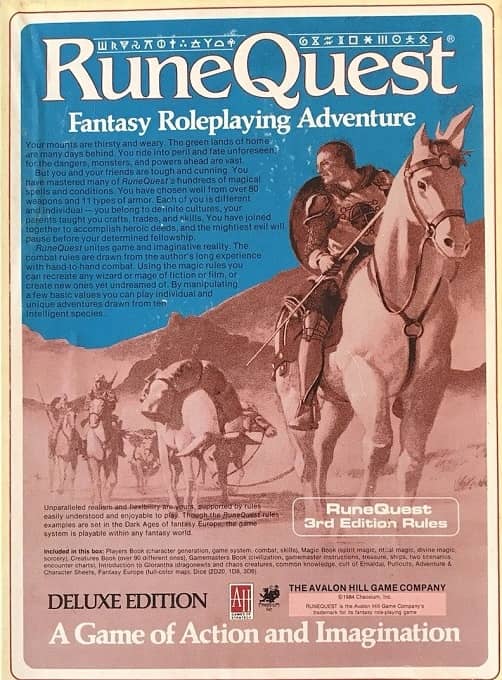 |
[This article was originally published in Tales of the Reaching Moon #5 in Spring, 1991, after the RuneQuest trademark had been sold to Avalon Hill and the game re-released in Deluxe and Standard boxed sets. Its publication was a catalyst for Avalon Hill bringing Ken Rolston on board and kicking off what became known as the (short-lived) “RuneQuest Renaissance.”
This article was actually based on a report commissioned by Avalon Hill itself in 1990 (prior to the decision to publish Eldarad). The original report was written by an award-winning game designer.]
Introduction
RuneQuest is a great game. We all know that. Unfortunately, things haven’t been going so good for the game for some time. We all know that too. We, the Tales of the Reaching Moon staff present here our thoughts about the history of the game, the hole RuneQuest is currently in, and what action we think Avalon Hill should take to dig its way out again.
[Click the images for high-resolution versions.]
We have no intention of pointing bones at either Avalon Hill or Chaosium; our intention is just to lay the facts as we see them on the table and suggest remedies. You will find our position is a conservative one. From our correspondence with Avalon Hill, we gain the impression that they’re eager to take the game to new places, to try to second-guess the market and provide what it seems to require. However, we believe it would be more useful for Avalon Hill to consolidate the present position before they try to expand.
Comment on this article is sought after and welcome. Perhaps you have ideas of your own. Let us know. More importantly, let Avalon Hill know what you think!
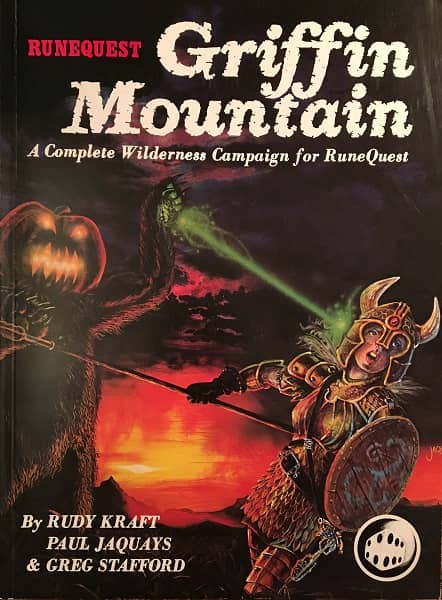 |
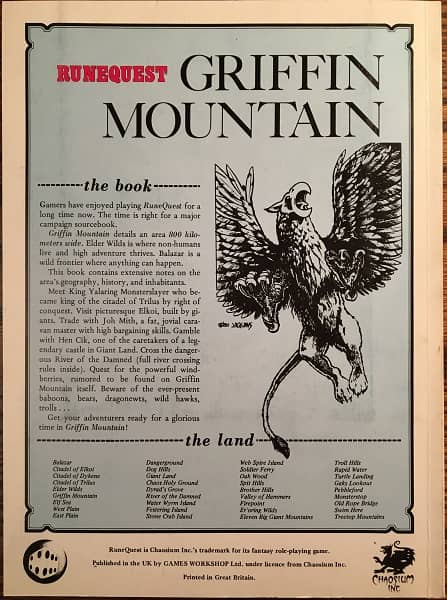 |
Chaosium’s Griffin Mountain (1981 Games Workshop edition)
Some Ancient History
The golden period for RuneQuest players was without doubt from 1982 – 1983, when the game won most of its fans. In that time Chaosium produced five excellent boxed sets: Questworld, Trollpak, Pavis, Borderlands and Big Rubble. The latter three boxes were a trilogy of adventures on the same geographical setting. (Pavis was cited by Ken Rolston in Dragon #156 as still one of the best all-time City supplements for roleplaying.)
Avalon Hill’s RuneQuest (Deluxe Third Edition)
The Avalon Hill Edition
After this frenetic publishing burst, RuneQuest went into hibernation while the Avalon Hill edition of the game was prepared. Players waited on the edge of their seats. The time delay was too long, and some started to drift off.
When the game did come out in 1984, it was bigger and better, but many were disappointed. The price was prohibitive; the physical quality could have been improved; and the rules had gained new complexities which some players were unable to cope with. But at any rate, RuneQuest was back. Some loved it, some decided to live with it, some deferred judgement, and some dropped it.
Glorantha was inseparable from RuneQuest in the earlier Chaosium editions; in the Avalon Hill edition it became optional. What was more important to gamers, the world or the rules? We are still finding out.
Those who stayed around looked eagerly for the first supplements, to get their hands on some new adventures to try out the revised rules. By and large they’re still waiting.
Four Kinds of RuneQuest
These days you can buy RuneQuest in four different flavours, and this has its own problems. In particular the advent of a watered-down version, Standard Edition, has created a number of extra hassles, although its principal aim — to make RuneQuest available at a lower price — has been realised.
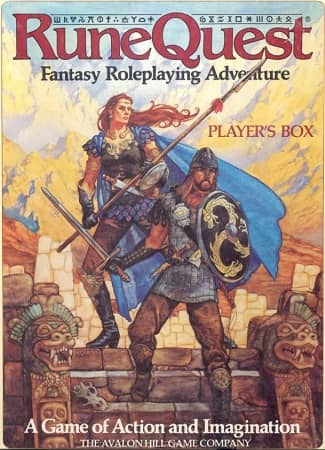 |
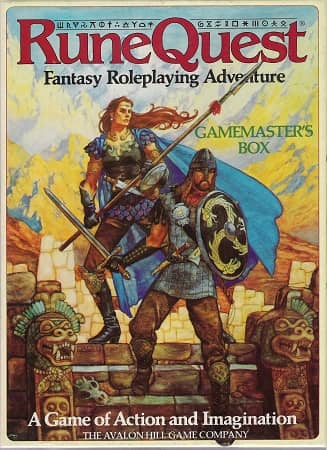 |
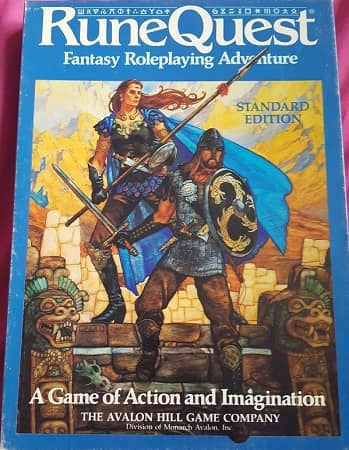 |
The four types of RuneQuest are:
- Deluxe: The basic RuneQuest unit. Ideally, everyone should buy this one. The price has (we think) dropped from its initial publication. Even so, it is the most sound investment on the roleplaying market, at any price.
- Player’s Box: A fair idea, making available a small portion of the game to those with limited budget or interest. However, RuneQuest is not a game like Dungeons and Dragons which requires an imbalance of knowledge between players and the gamemaster; ideally, everyone should buy Deluxe instead. We know of one games shop in 1989 that took nine months to sell one copy of the Player’s version.
- Gamemaster’s Box: An odd set. By itself, it’s not only half a game, but it’s the wrong half. No Gamemaster would buy this without the Player’s box, unless he or she was an idiot; in other words, again it makes more sense to buy Deluxe and get it over with. The only consumers that the Gamemaster’s Set would be of real use to is those who bought Player’s first, and then wanted to go the whole hog. Alternately, there may be gaming groups out there who are so communal-minded that the players bought their box and the gamemaster bought theirs and they all lived happily ever after — but we doubt it.
- Standard Edition: Aha. A kettle of worms, this. A valiant attempt to bring the price down; this is RuneQuest lite. But the same problem exists, that is, once they’ve bought Standard, if they like it then sooner or later they’re going to have to spring for Deluxe anyway. To ward this off, RuneQuest supplements have included Deluxe rules sections for Standard players, but this frustrating for those who already own Deluxe (and are thus paying for pages they don’t need).
RuneQuest Gamemaster’s Box
Here are four possible solutions to the Standard Edition bottleneck:
(a) Continue on including Deluxe rules sections. As we’ve said, we think this is annoying for Deluxe owners.
(b) Let the Standard players suffer. Give no ground, let them sink or swim. This is unsatisfactory, as it betrays the trust of those who took the carrot and bought Standard in the first place.
(c) Produce a Standard Edition Update, much like the Games Workshop Advanced RuneQuest book. It will be annoying to use, because players will find themselves needing two sources to look up the same information; but no more inconvenient than the current situation for Standard Edition users. However, it would be cheaper than having to start all over again by purchasing Deluxe.
(d) Continue to do the Deluxe rules sections for each new supplement but, instead of making them part of the text, make them available for free by having the consumer send in a stamped self-addressed envelope. Standard users don’t miss out, and Deluxe users don’t find themselves with material they don’t need. Of the four, we think this is the preferred option.
The Supplements: Overview
Discounting the different versions of the rules, from 1985 – 1990 Avalon Hill has published 19 supplements for RuneQuest. Averaged out, that’s about three per year. In fact, in the last two years, the rate has dropped to two per year. That hasn’t been enough.
Many of the supplements have failed to catch the imagination of the original RuneQuest players, who have seen them before.
Looking at the contents of the published supplements:
New Material — 6 box, 1 book
Reprinted Material — 2 box, 5 book
Useless Material — 3 box, 1 book
New and Reprint are blurry categories; some of the New products contain old content, some of the Reprint products contain new information. Our rule-of-thumb for the distinction between New and Reprint is whether or not an old RuneQuester would feel compelled to buy it. By useless material, we callously mean products of little use or value.
By our reckoning then, only 5 supplements have contained substantially new material, less than one third of the total output, or less than one per year. If we further differentiate between Glorantha and Alternate Earth, there has been only one brand new Gloranthan supplement out for every two years.
We think you may start to see why RuneQuest has failed to charge ahead.
The Supplements in Detail
Here are our thoughts on the 18 things thus far released. We think that the ones marked with an asterisk (*) have been strongest sellers. We do not have access to full records of RuneQuest sales, although we do know which ones have gone well in shops we have worked in or are familiar with. Still, we are fairly confident that our assessments are close to the mark.
A general comment applies to all the boxed sets. Paper-covered books are not sturdy enough for roleplaying use, which is more vigorous than that of a set of boardgame rules. This has been a constant problem and complaint.
Here we go. We use the copyright dates, even though they are not necessarily the year the item came out:
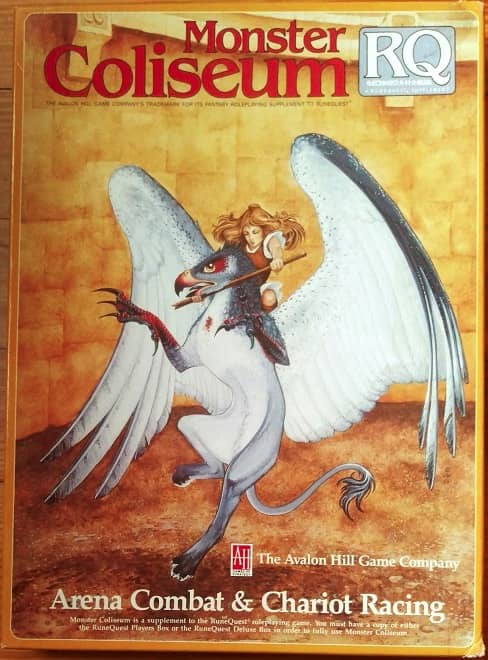 |
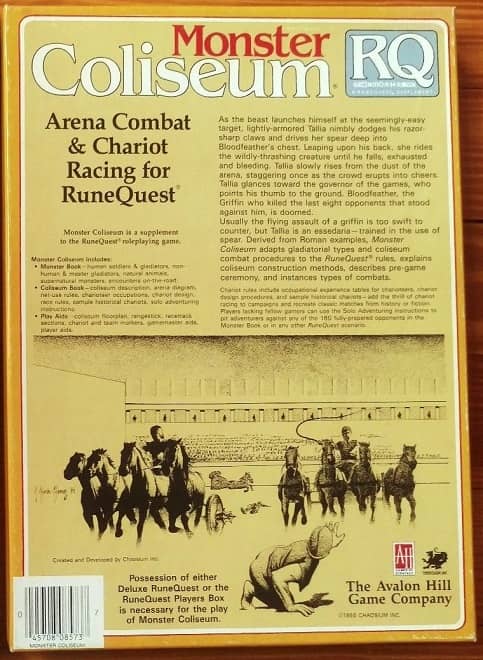 |
Monster Coliseum (box, useless, 1985)
An arena combat supplement. The maps and components were handsome, but players were simply unlikely to get a lot of use out of it. The monsters had lasting use, but at US$16.00, the set just wasn’t worth it.
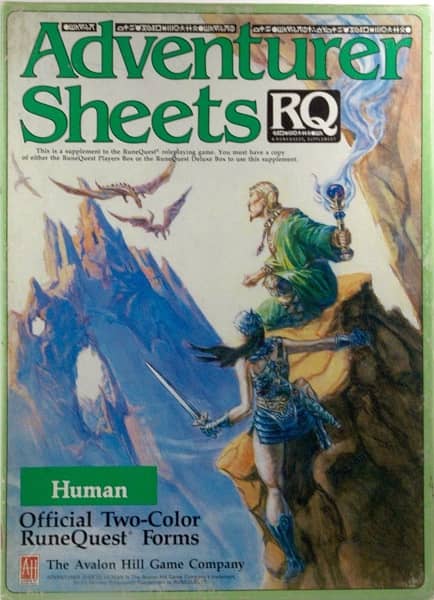 |
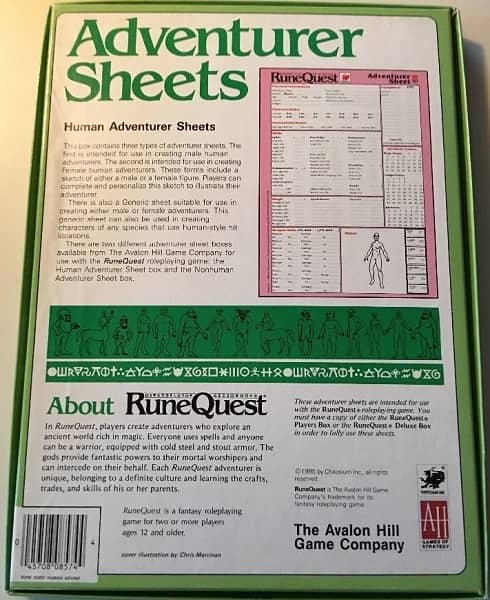 |
Adventurer Sheets [Human] (box, useless, 1985)
The game itself provides you with character sheets to photocopy. This was simply unnecessary, and Avalon Hill had the gall to call a pad of character sheets “Supplement #2”!
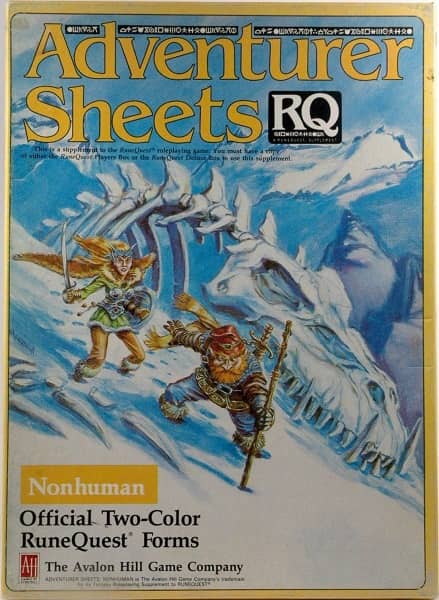 |
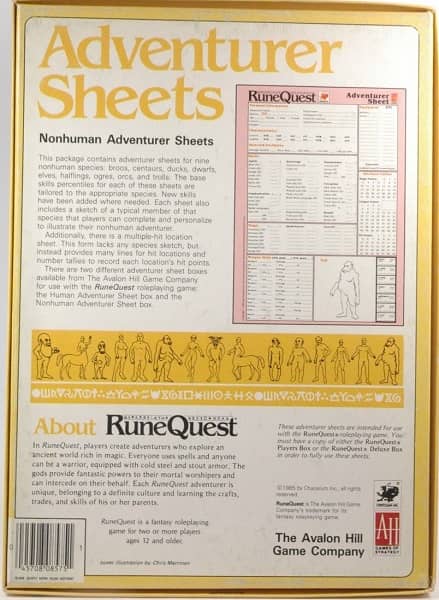 |
Adventurer Sheets [Nonhuman] (box, useless, 1985)
Of marginally more use than the Human set, but still not really value for money.
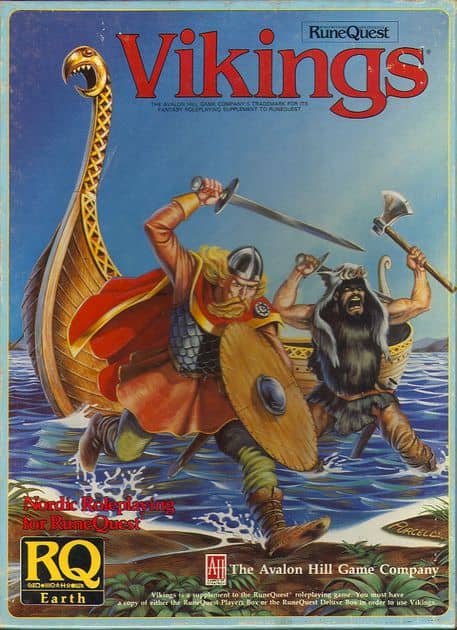 |
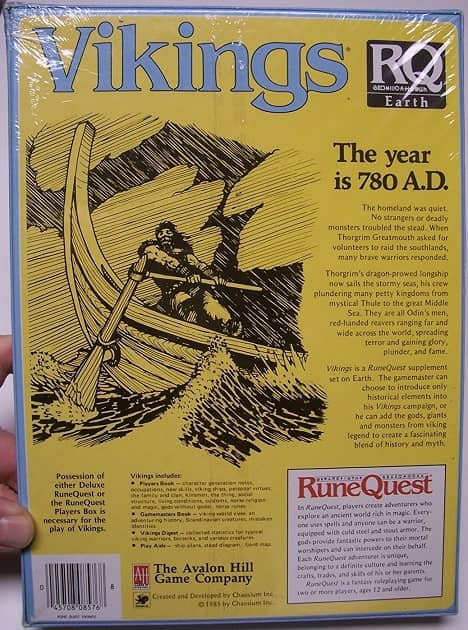 |
Vikings* (box, new, 1985)
The first Alternate Earth supplement, a great set. Many hours of solid play was available from it. We know of one Vikings campaign which now five years old, and still going strong (a saga in the making!).
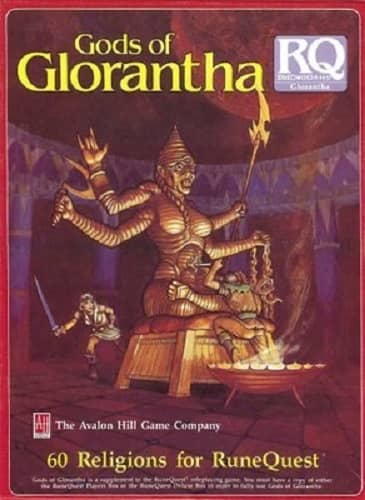 |
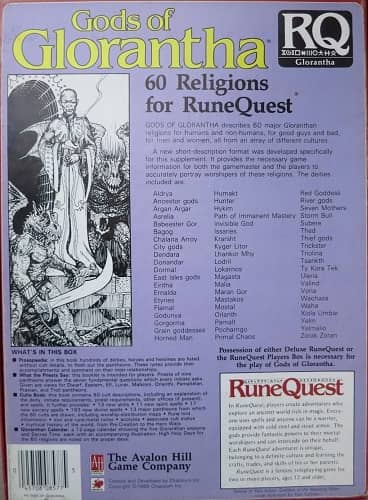 |
Gods of Glorantha* (box, new, 1985)
The first Glorantha supplement. Indispensable background material.
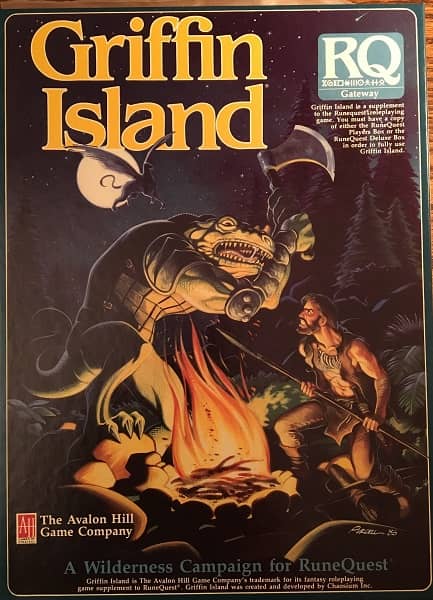 |
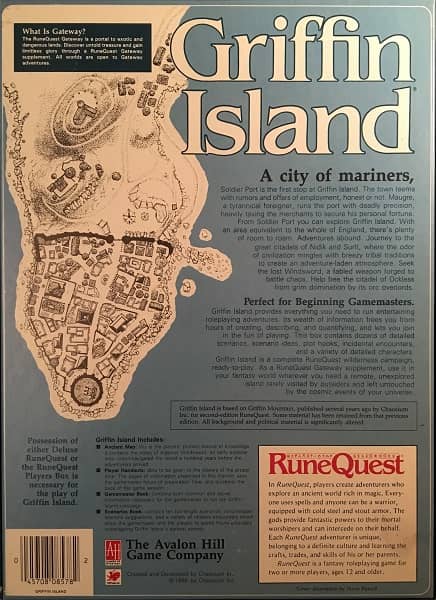 |
Griffin Island (box, reprint, 1986)
Old adventures transplanted to a new setting; even so, people who had played Griffin Mountain were unlikely to get use out of this.
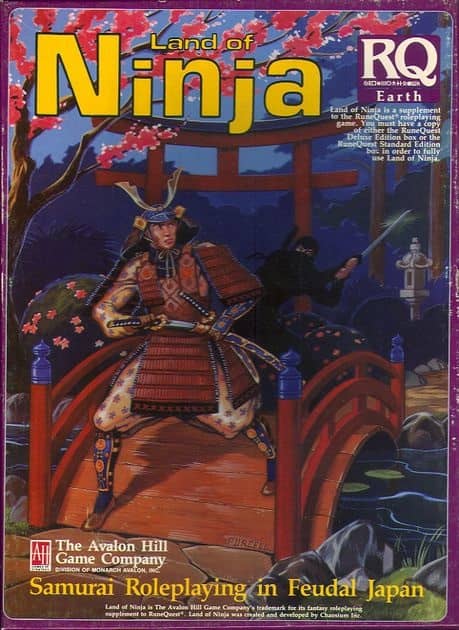 |
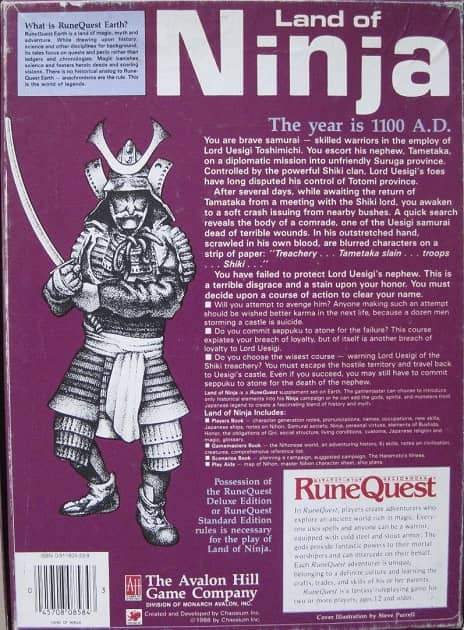 |
Land of Ninja (box, new, 1986)
Second and perhaps last of the Alternate Earth supplements. Despite its somewhat misleading title (the ninja are only a peripheral element in the game), a fine set. As the majority of roleplayers are more accustomed to Eurocentric adventuring, Land of Ninja was perhaps of less universal appeal than Vikings. This makes us wonder about the commercial viability of Aztecs, a manuscript currently in the hands of Avalon Hill.
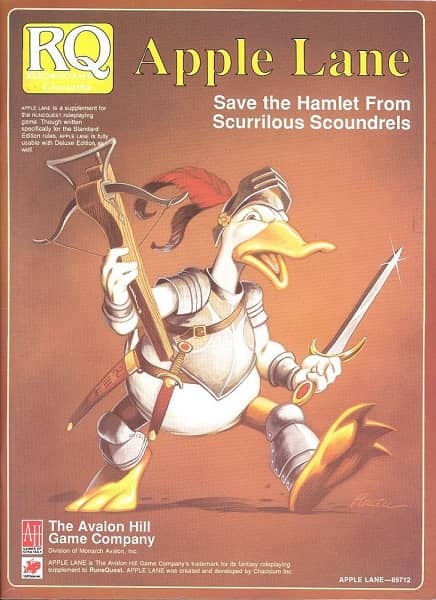 |
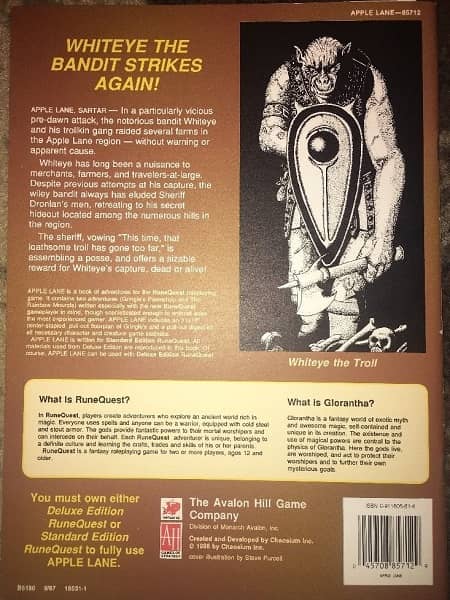 |
Apple Lane (book, reprint, 1988)
A classic adventure, but an old one. The first of the book releases, bringing the price of the average RuneQuest item a little closer to the pocketmoney budget.
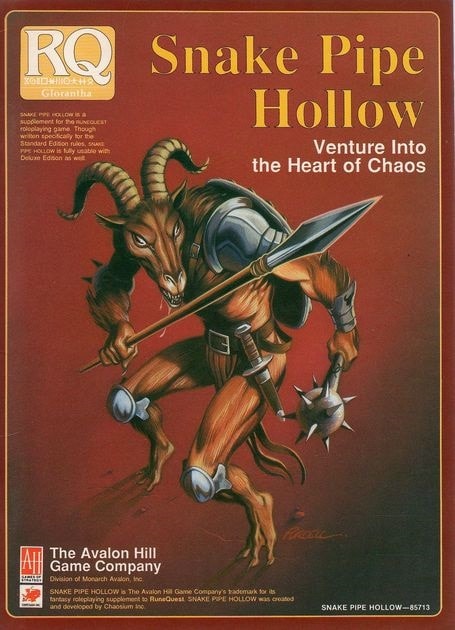 |
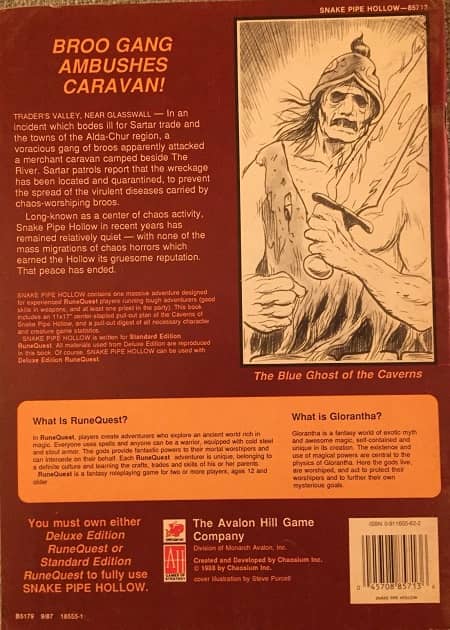 |
Snakepipe Hollow (book, reprint, 1988)
See above.
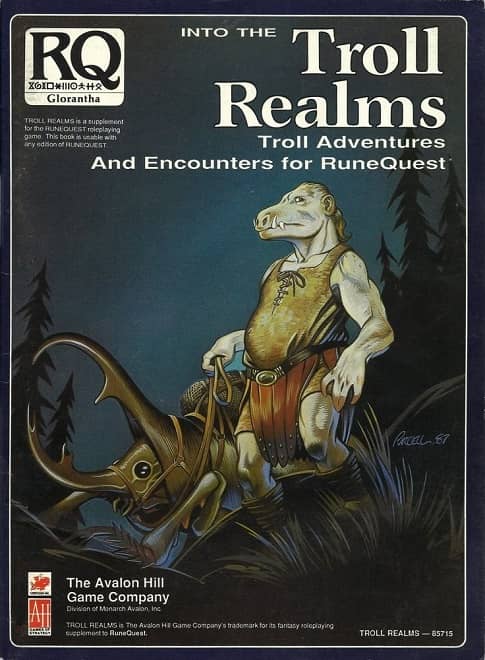 |
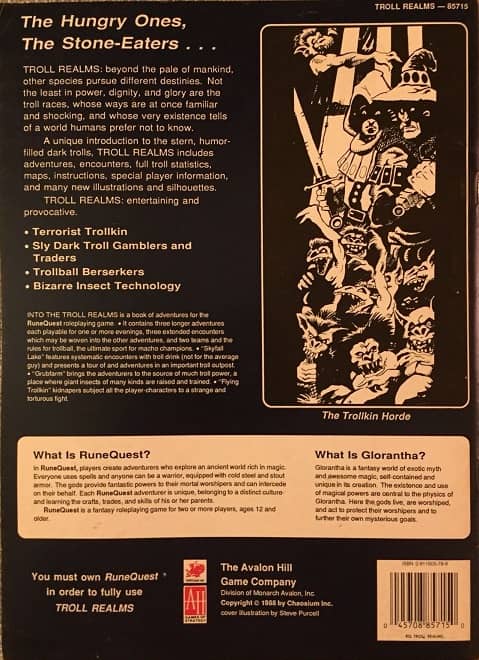 |
Into the Troll Realms (book, reprint, 1988)
The first of the trolls. Somehow the single 1982 boxed set Trollpak was turned into four separate reprints. Owners of the original were usually unlikely to buy any of them.
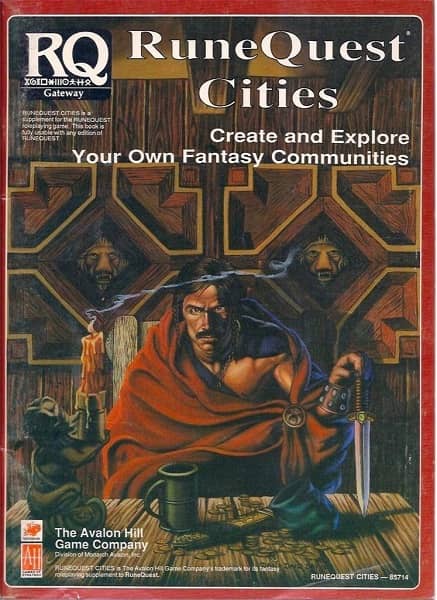 |
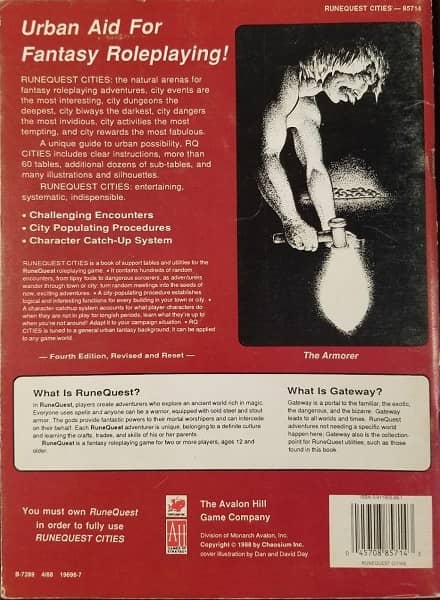 |
RuneQuest Cities (book, reprint, 1988)
Unlike the other reprints, this supplement was not a RuneQuest one in its original publication. It’s a useful book, but not one that everyone would feel compelled to purchase.
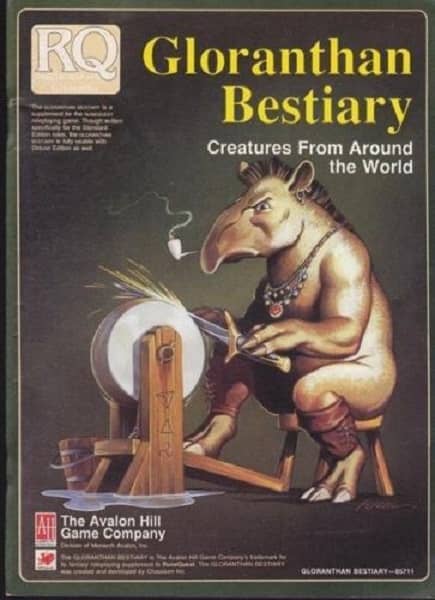 |
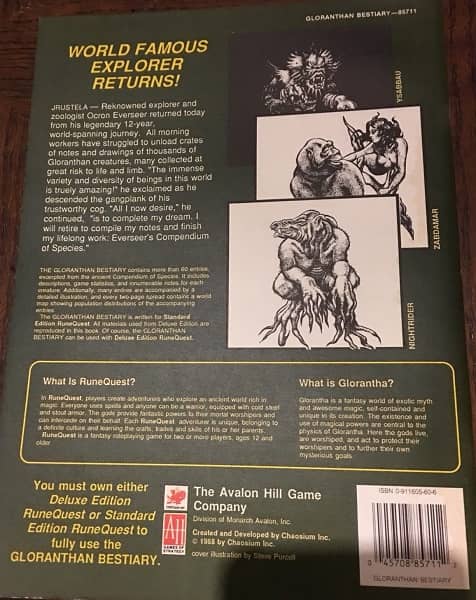 |
Gloranthan Bestiary* (book, new, 1988)
New monsters for Glorantha. A must for all Gloranthan RuneQuesters.
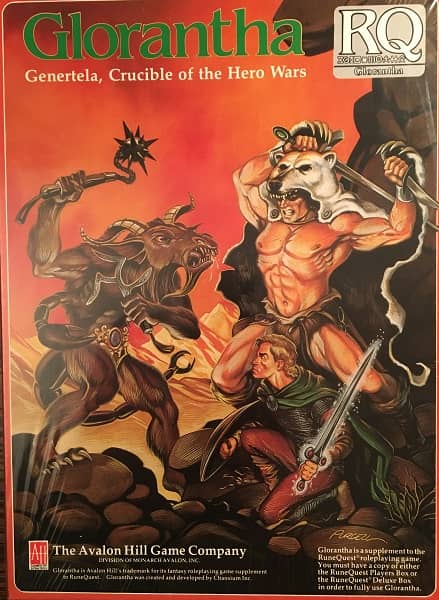 |
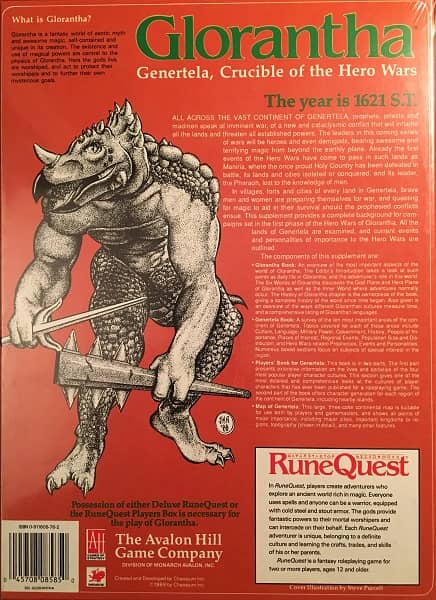 |
Glorantha – Genertela* (box, new, 1988)
The one everyone was waiting for, the strong launch that Gloranthan fans had been looking for since 1983. A great pack, rich in background details.
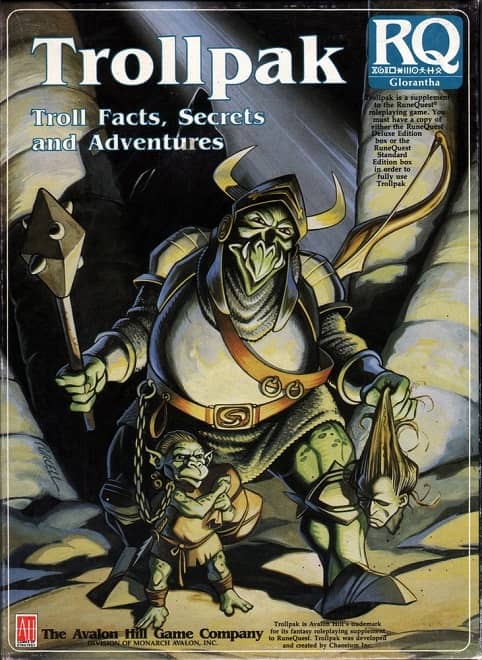 |
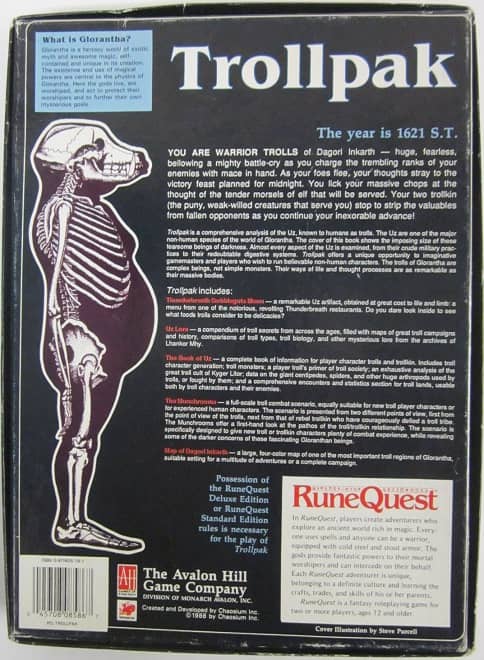 |
Trollpak (box, reprint, 1988)
More trolls.
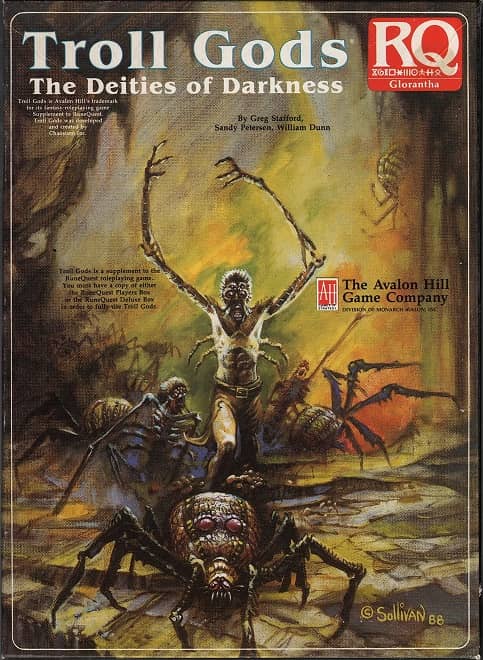 |
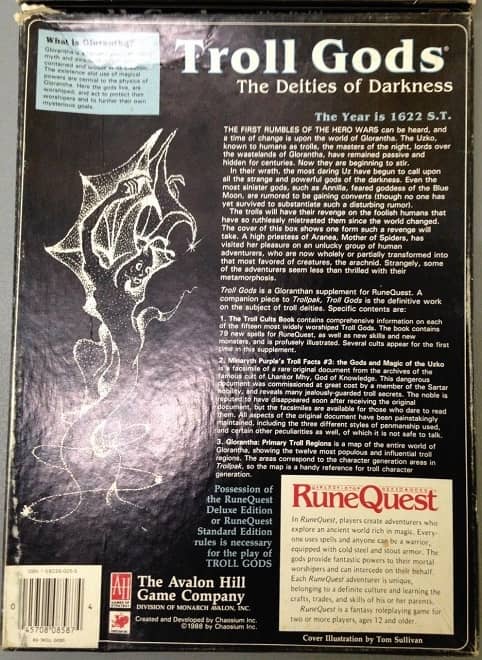 |
Troll Gods (box, new, 1988)
And more trolls. This one is significant because of the poor quality of the artwork. Prior to this, although much of the material was familiar to them, players and collectors had been enjoying a sound aesthetic feel in all RuneQuest products in both layout and art — you might buy them just to have them. Troll Gods eroded confidence in new product.
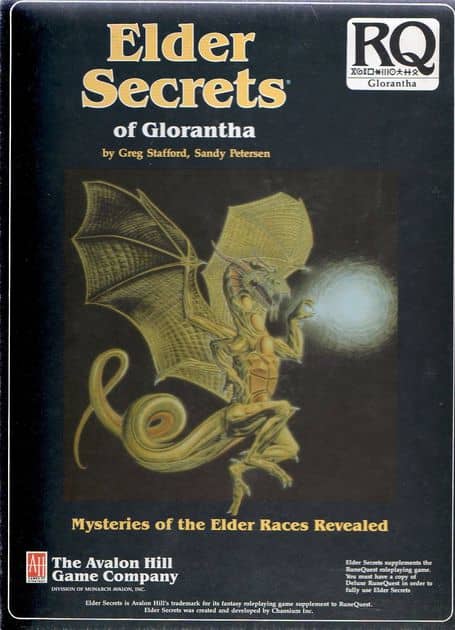 |
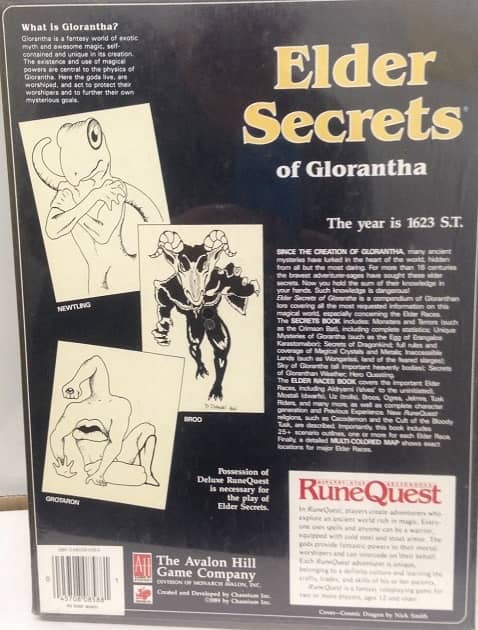 |
Elder Secrets* (box, new, 1989)
Like Glorantha, a box that Glorantha fans were waiting for. Like Troll Gods, it was marred by unforgivably bad artwork. Still, it did sell well. Only the first release of the AD&D 2nd Edition hardbacks sold quicker than Elder Secrets in several games shops we know of.
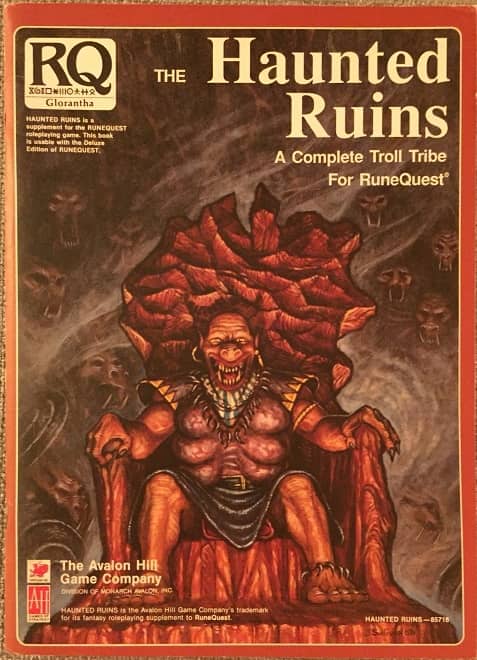 |
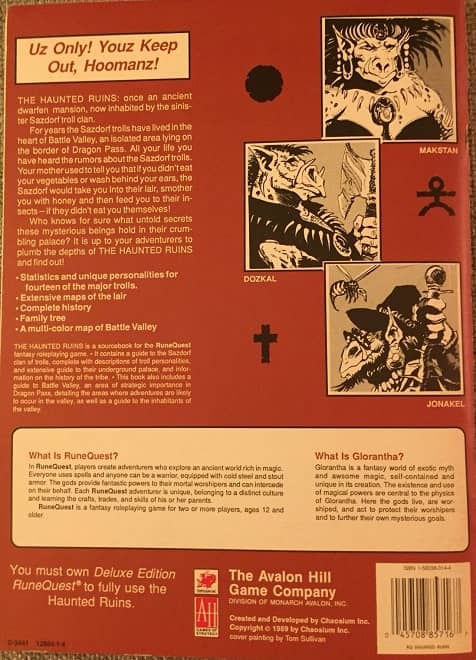 |
Haunted Ruins (book, reprint, 1989)
The last of the trolls. Thankfully, the artwork this time was greatly improved.
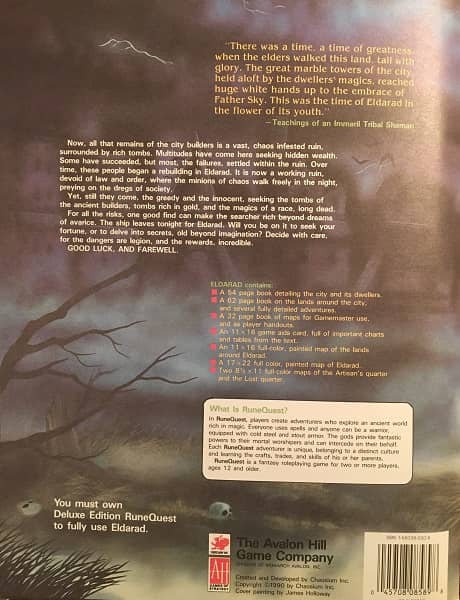 |
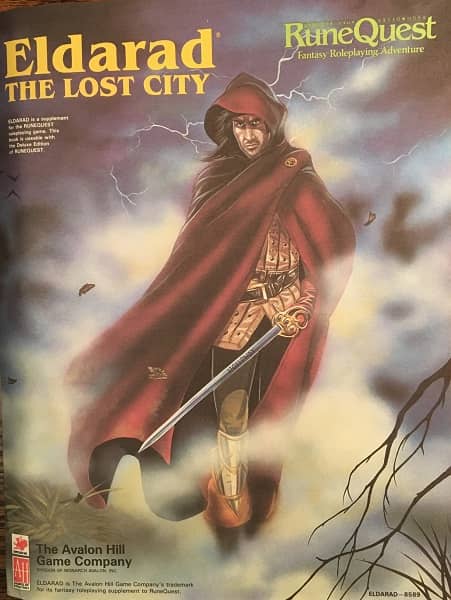 |
The Lost City of Eldarad (books in card wallet, useless, 1990)
A total turkey, this non-Gloranthan supplement fails on almost every level. Unoriginal concept, execrable writing, uninspired layout and poor artwork. A real blow to the confidence of RuneQuesters in Avalon Hill’s ability to produce RuneQuest effectively. It is not unfair to question Avalon Hill’s lack of discernment to ever accept this manuscript, let alone go to the trouble of printing and marketing it.
The Supplements: Summary
Background material enriches a game, and it is the quality of the background material on which the fame of RuneQuest is based. Nevertheless, players also have a need of something they can buy off the shelves, flip open the cover, and start running on a Friday night. Avalon Hill RuneQuest has had some releases of this type, but it has all been reprints. A common lament amongst former RuneQuest players is “We want to play RuneQuest, but there’s nothing to play.”
As gamemasters, we have a need of things we can use with minimum effort. Over the last eight years we have had no new commercial campaigns to use (excepting Eldarad and Daughters of Darkness). Those of us who can, have had to use the background in the 1982-1983 material, or have written our own.
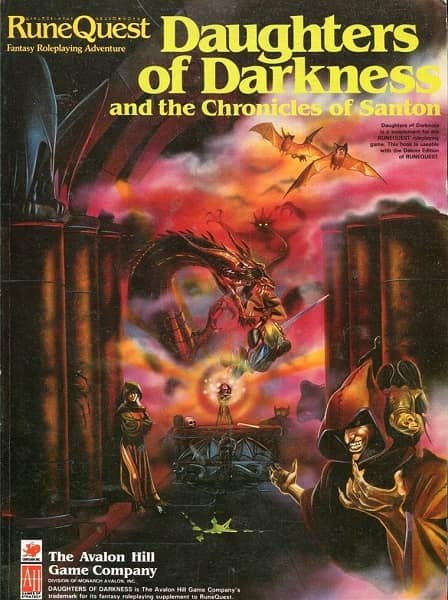 |
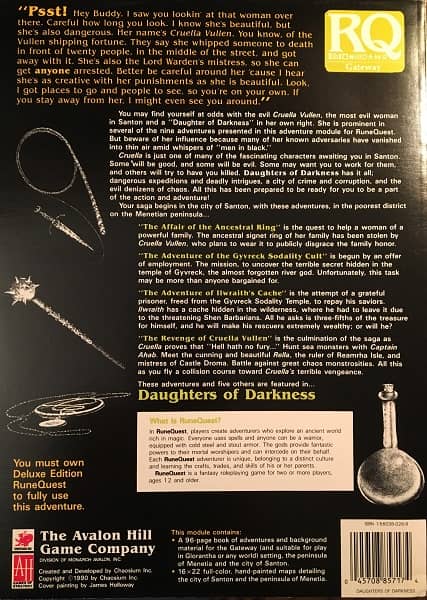 |
So What Should be Done?
RuneQuest as it stands is a great fantasy roleplaying game. It is as good as and better than Rolemaster, AD&D, Middle Earth and the rest of them. What those games have that RuneQuest doesn’t is a torrent of new support material, on a regular basis.
We don’t propose any radical in direction. We believe that solid work is all that it will take to get those gamers looking RuneQuest‘s way again. To the players, the format is fine, the look is fine (some artwork notwithstanding), there just isn’t enough of it.
Michael O’Brien became vice president of Chaosium in August 2015. The 1992 RuneQuest-Glorantha release Sun County, which he wrote for Avalon Hill working with editor Ken “The Rune Czar” Rolston, kicked off the relatively brief but creatively fertile period which later became known as the “RQ Renaissance”. Although based in Australia, at the time O’Brien was associate editor of Tales of the Reaching Moon, the influential British fanzine that helped sustain Gloranthan fandom through the 1990s and early 2000s.
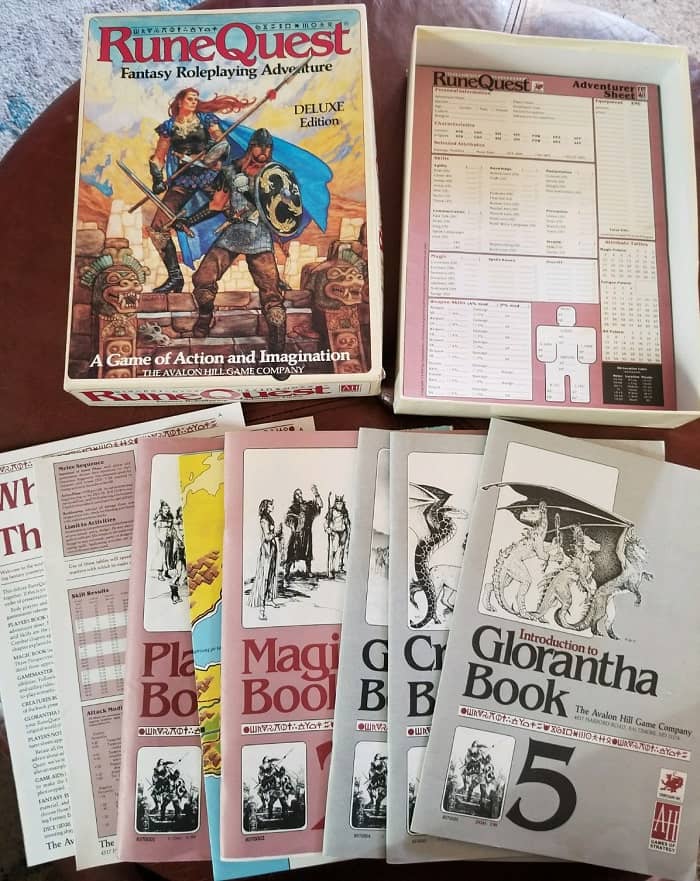
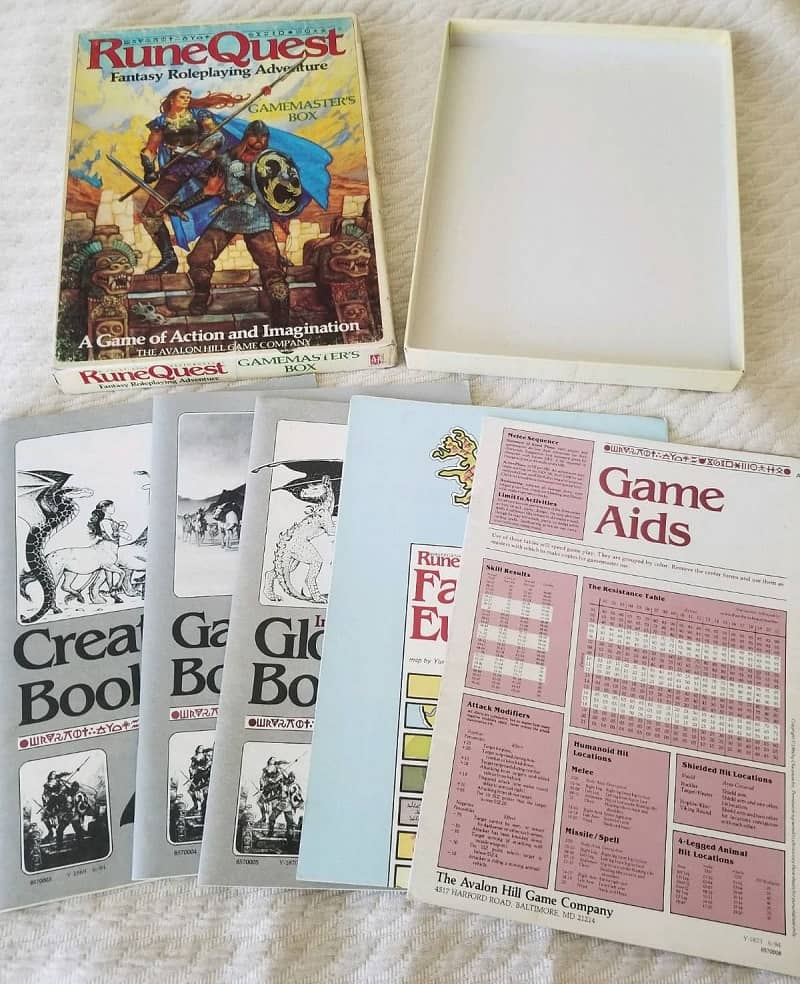
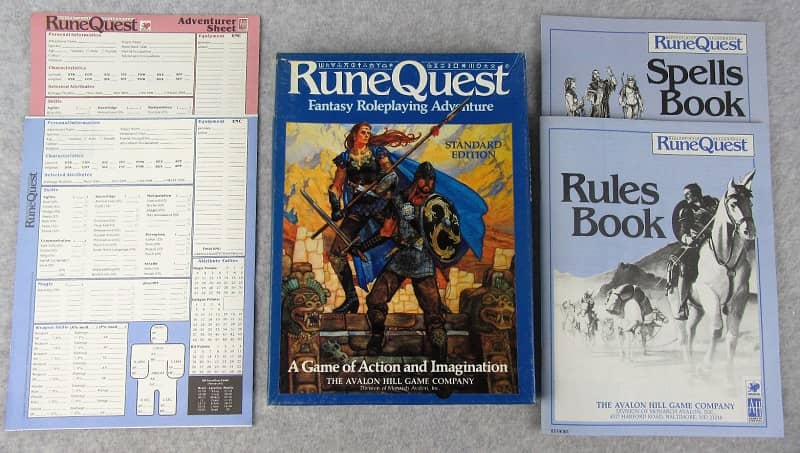
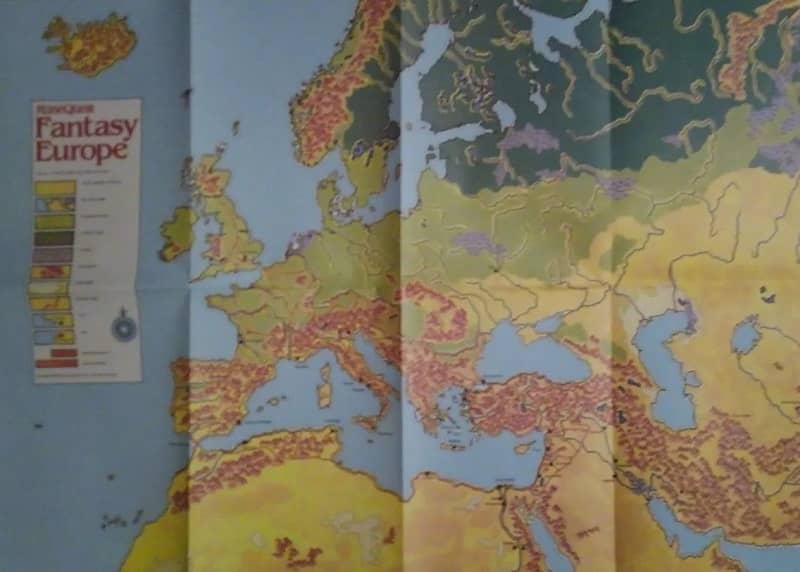
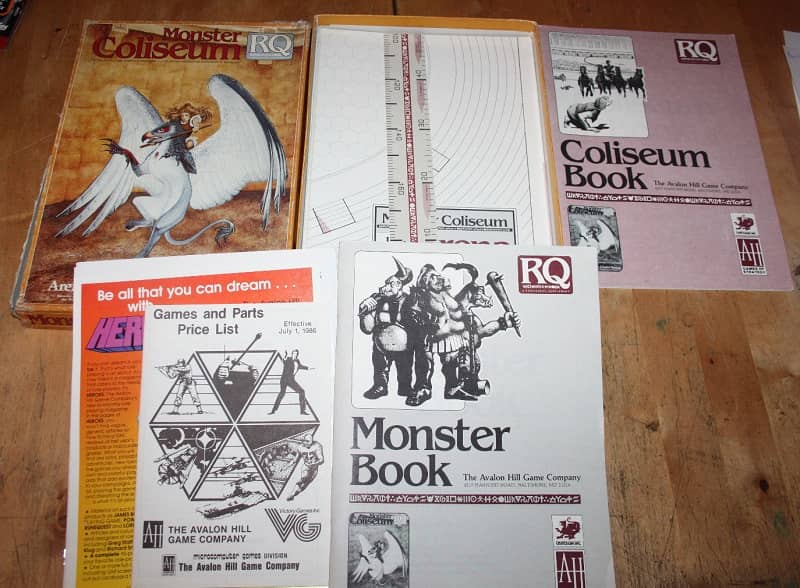
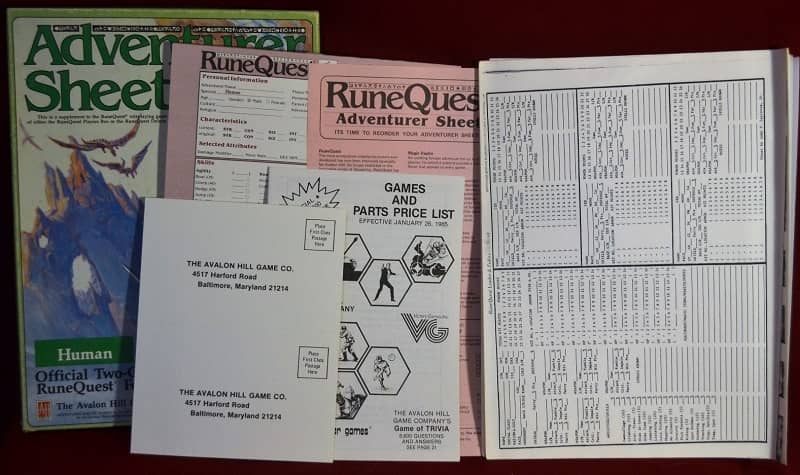
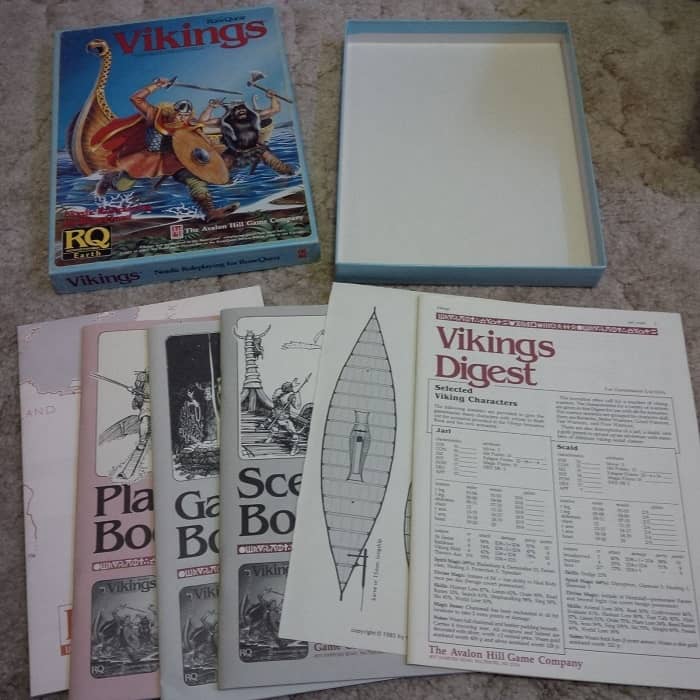
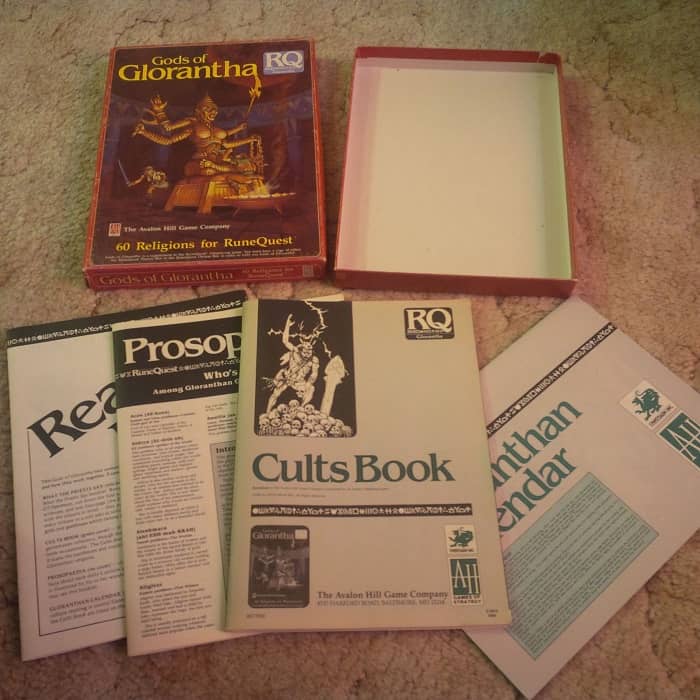
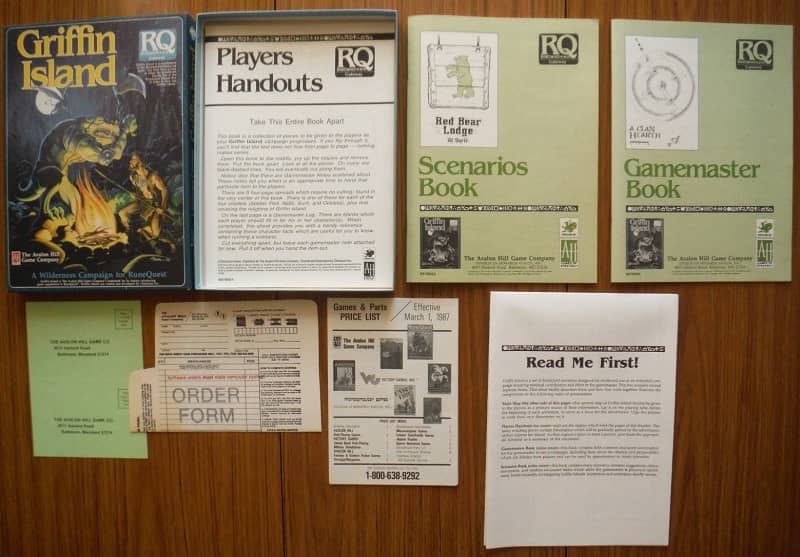
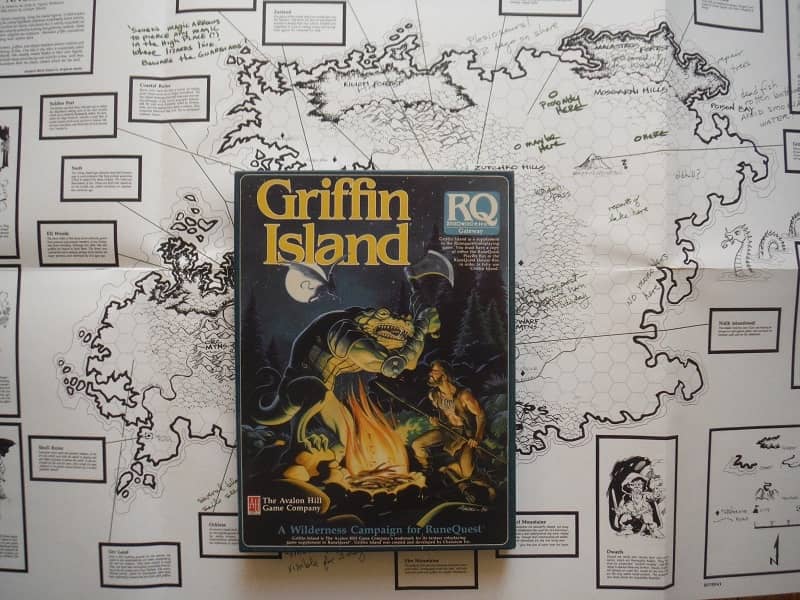
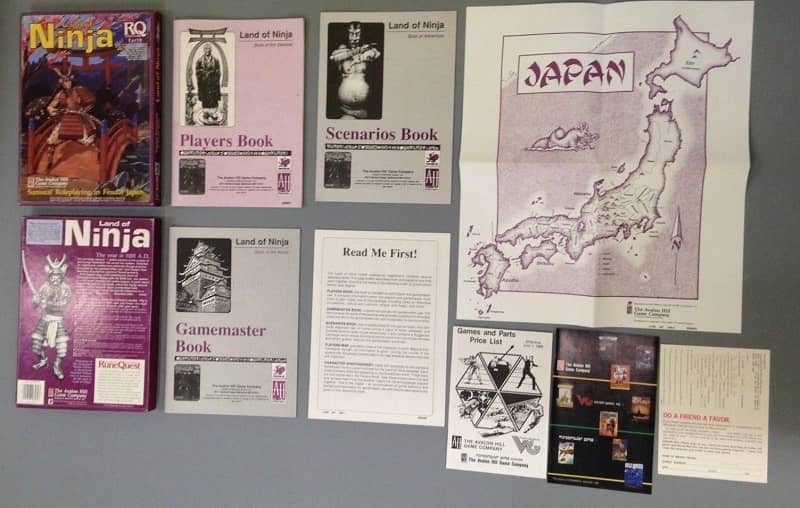
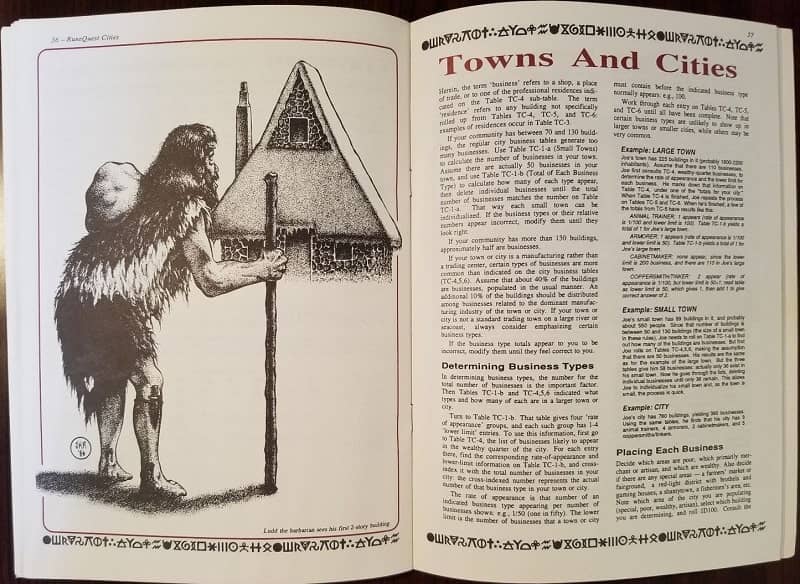
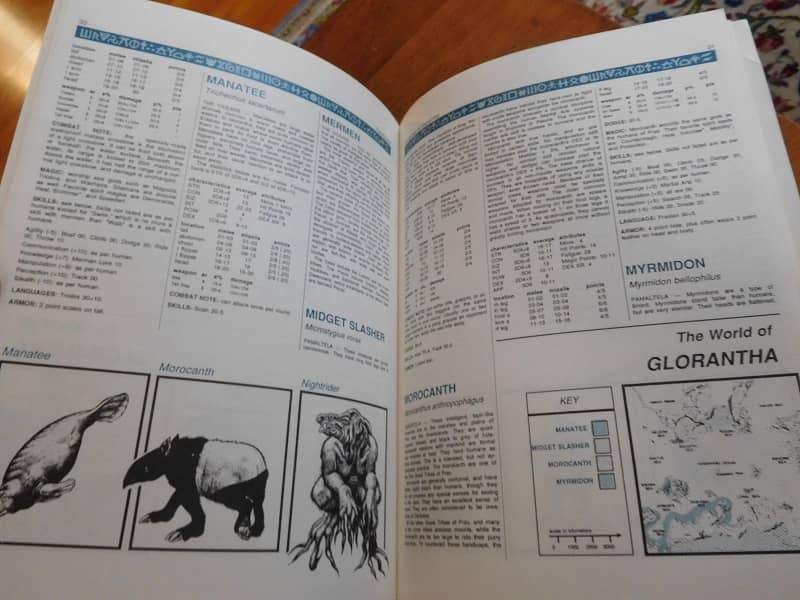
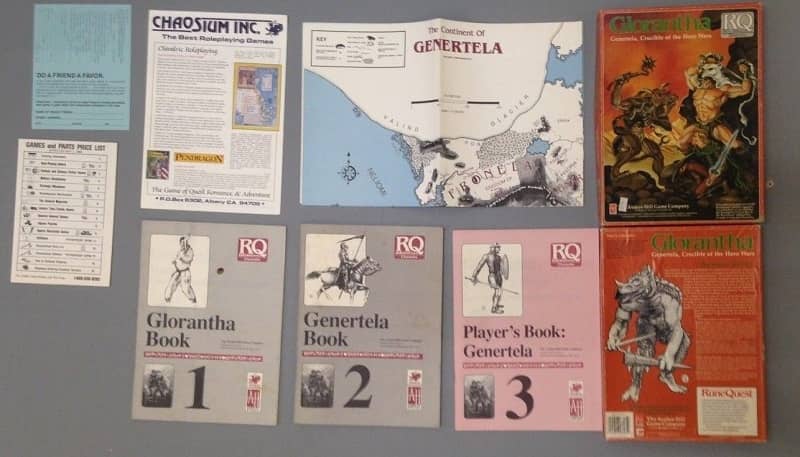
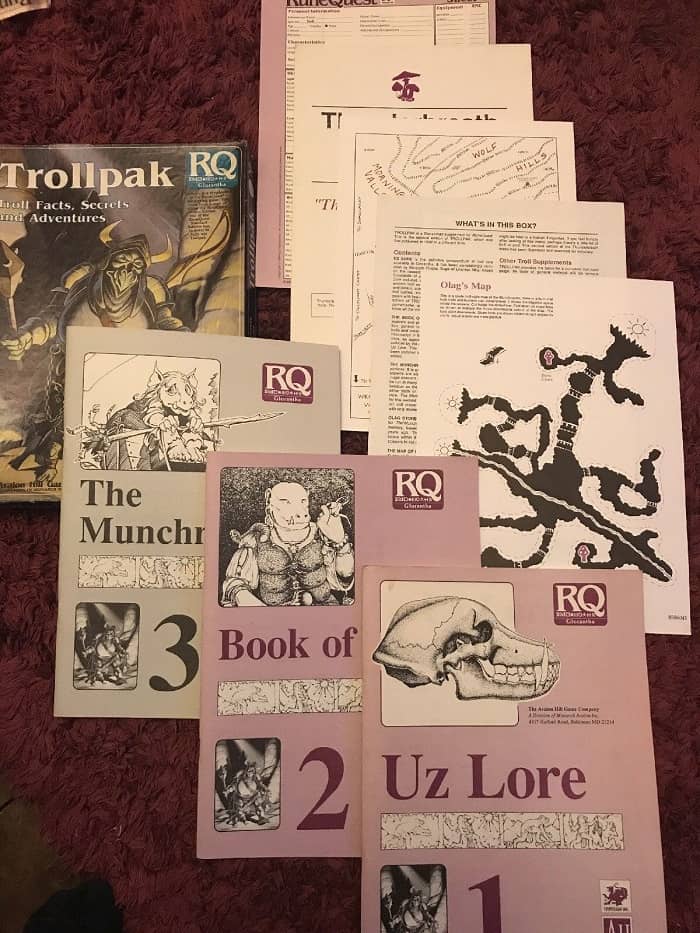
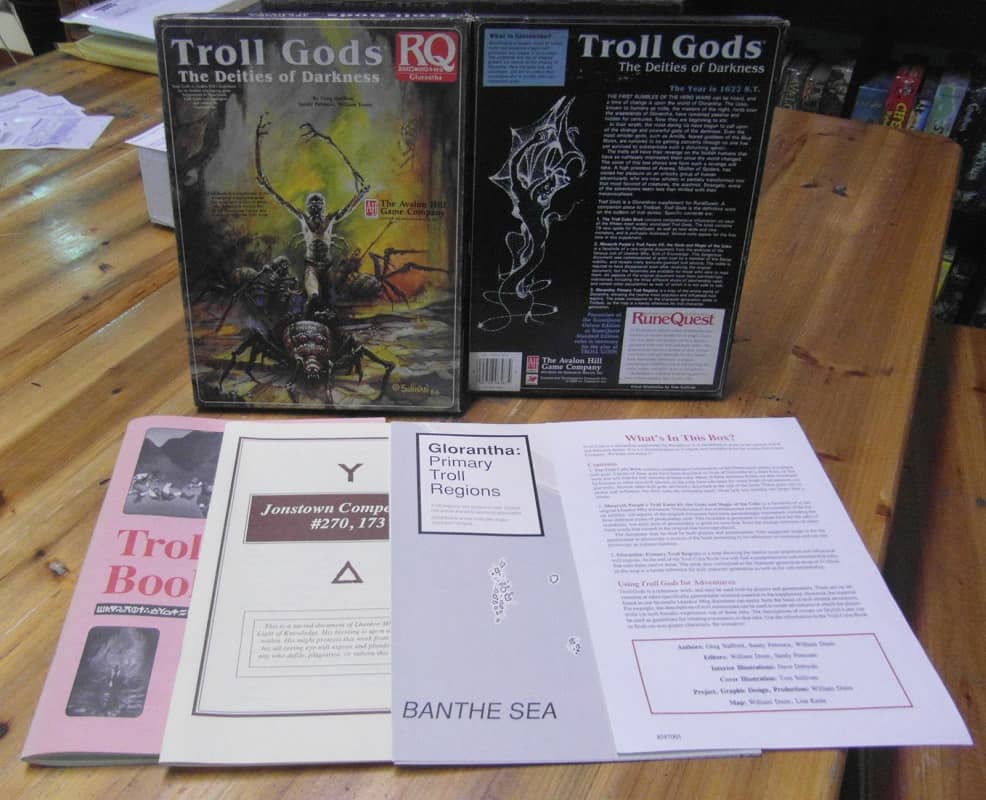
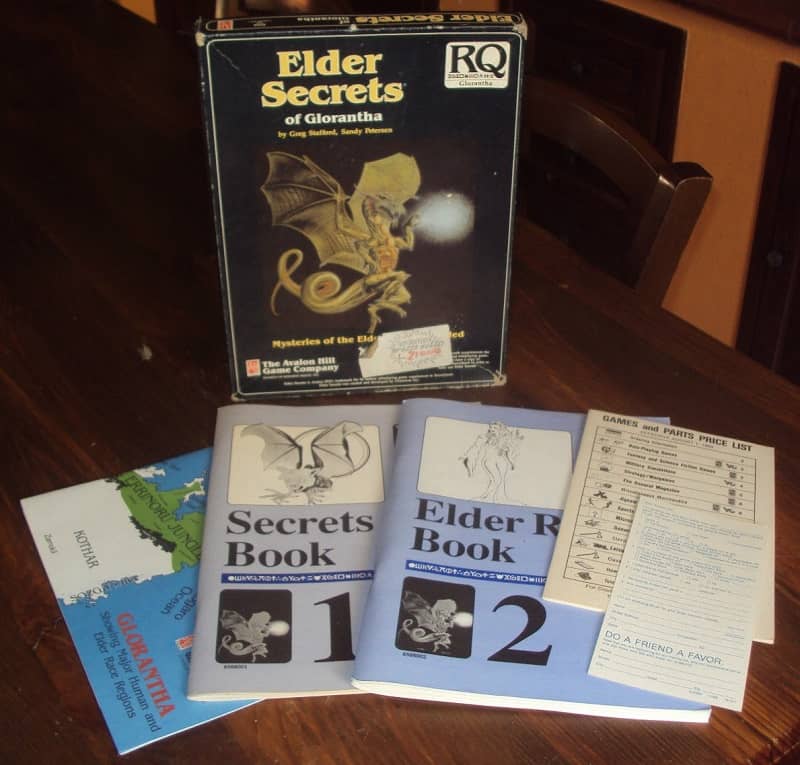
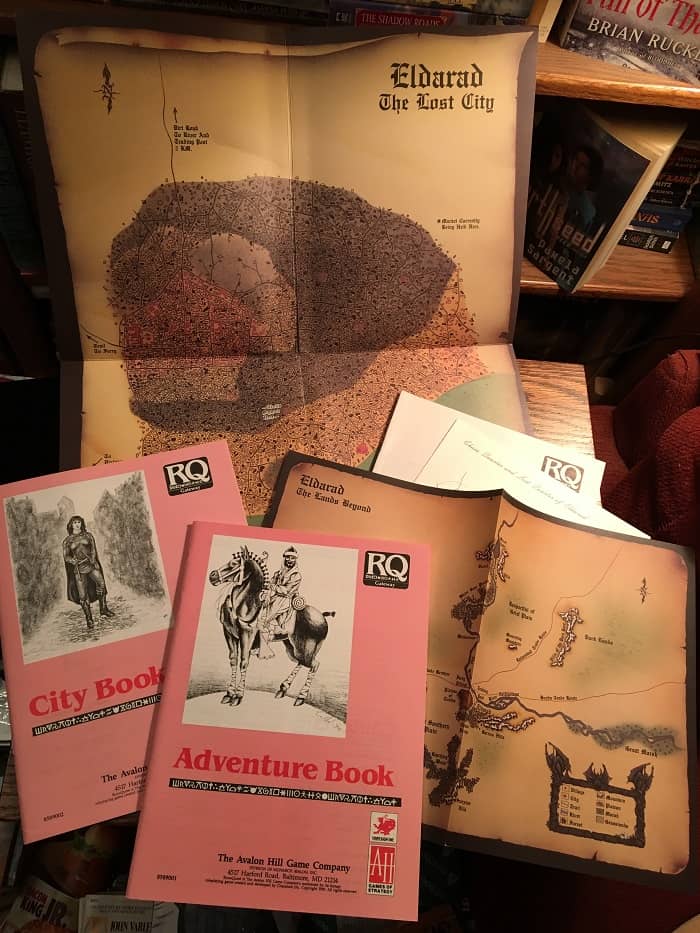
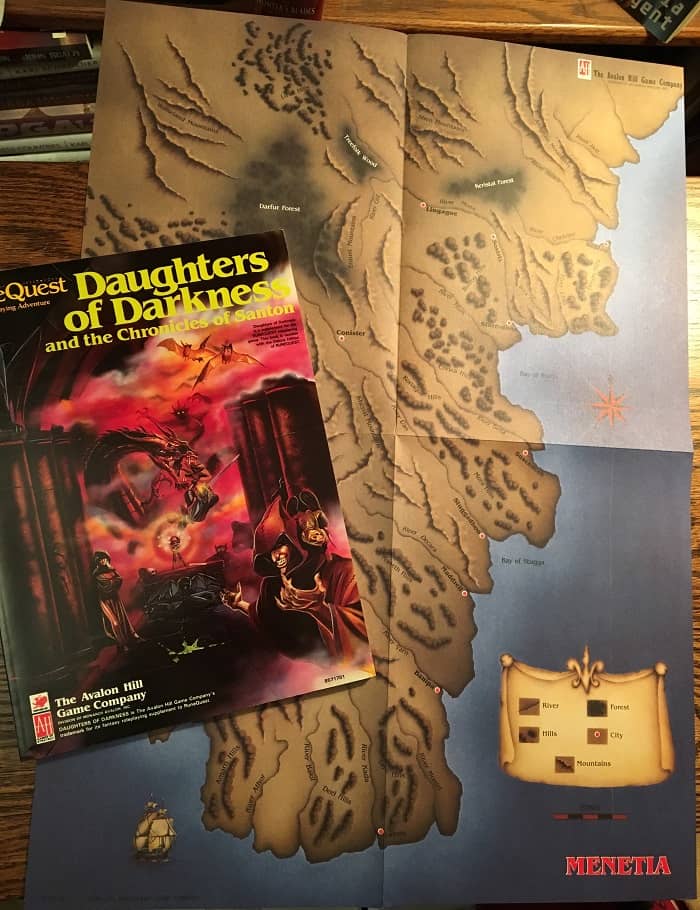
RuneQuest is one of those that I’ve always kind of admired from a distance. I remember seeing very positive reviews of some of the boxed sets in Dragon Magazine, and I did pick up a couple of them at one point or another, but not enough to really wrap my head around the setting.
I cut my teeth on the Avalon Hill version and Games Workshop releases of the same. So for me this I never grew up with the Interlocked With Glorantha setting. One merely has to ask any RQ 2nd ed fan about this and they will get glossy eyed and wax lyrical before winging about RQ3 (Avalon Hill). But for sure, even the RQ renaissance that saw Avalon Hill publish Shadows on the Borderland, Sun County, River of Cradles and strangers in Prax, all possibly some of their best material, was a little too late the damage had been done so to speak.
I think there are a lot of opinions out there, as well as some genuinely scary stories, but from a pure business perspective I think Avalon Hill had caught the classic corporate disease and become alienated from its customers. They were never really a RPG house and I reckon they misread the market and in effect alienated their existing (inherited) customer base while failing (through aforementioned dismal tactics) to bring in a huge influx of new punters. One sees this kind of thing in many industries. (Who remembers Lotus, or IBM’s OS2, or BlackBerry…).
What was interesting is that the hard core Gloranthafiles found a new fox’s for their ire, none other than Greg Stafford (Gloranthas’ creator) when through Hero Wars, refined as Hero Quest (Milton bradleys licence of that name having expired) and then Mongooses revised RuneQuest (aka MRQ or RQ4) the world moved on into a new age…
Forgot to mention. I still play RQ, the draw card for me was always the system. It’s either a system one loves or hates. It’s realistic, albeit a bit complex. In RQ your character can die with ease. No clerics wandering around raising party members every few steps.
A last info byte: RQ Cities was a re publishing of the old Midkemia Press (yes you read right midkemia as in R.E. Feist Magician etc) Cities book. Not sure how this came to be but if one considers Chaosium republished the Carse and Tulan of the Isles books from Midkemia Press and Chaosium were still involved with RQ3 (AH) one could connect the dots.
Tony,
I forgot Cities was originally a Midkemia product. I bought all the Midkemia supplements as they were released, and really enjoyed them… but that was a long time ago, and clearly my memory is fading!
Most of the Avalon Hill RuneQuest products above are available at pretty reasonable prices online as well. The boxed sets have been creeping up over the years, but I think supply still outstrips demand for many of them. In large part these are excellent products, well worth tracking down.
I suspect that the Midkemia “bleedthrough” into RuneQuest was a result of their Cities supplement also providing much of the urban encounters/city-building engine for Chaosium’s Thieves’ World supplement. I have both editions of the Midkemia Cities, but I never picked up the Avalon Hill version, alas.
Good point Eugene. Thieves world is still on my wish-list. One day…
John – right you are, if you look around you can even still get certain supplements in shrink. Back in the day when I was rounding out my collection and the local supplier had dried up I got various bits and bobs from many a small mail order shop, before turning to the then quite new eBay.
I agree with Mr. Den’s analysis of Avalon Hill. In my opinion, they never understood role playing games and just did not care for fantasy. AH’s inability to produce new content for RQ was so bad that even as late as 2001-2002, I was running into people at conventions who thought that Avalon Hill had stopped publishing the game in the early 90’s.
Keep your eyes open for a copy of Thieves World, it is worth it.
Tony,
I second Mr. Boyle’s recommendation… the Chaosium Thieves’ World boxed set is one of the greatest gaming aids ever created. Unlike most of the boxed sets above, however, these days it is a highly prized collector’s item. eBay has nearly a dozen copies on offer at the moment, with prices ranging from $60 – $250. Although there is one copy in good shape but missing the maze map, with bidding currently at just $15:
https://www.ebay.com/itm/Robert-L-Asprins-THIEVES-WORLD-Complete-Sanctuary-Adventure-Pack-2007-X/142633160343
A bit of extra historical context: In the early 80’s, Chaosium’s 2nd Ed RuneQuest was second only to Dungeons & Dragons in popularity and sales. But by 1990, Avalon Hill wanted to know why their 3rd edition of the game just wasn’t setting the world on fire they way they hoped it would, and commissioned a report for some answers. Tales of the Reaching Moon released the report as the “Resurrecting RuneQuest” article in Tales #5. Its publication was a catalyst for Avalon Hill bringing Ken “The Rune Czar” Rolston on board and kicking off the relatively brief but creatively fertile period which later became known as the “RQ Renaissance”.
I was part of the Tales of the Reaching Moon editorial team, along with current Chaosium president Rick Meints. There are salutary points made in the Resurrecting RuneQuest article—a key one being RQ3’s crippling lack of *new* Glorantha scenario material (AH finally published my book Sun County, the first release of the “RQ Renaissance”, *eight years* after RQ3 came out). We won’t be making the same mistakes with the new Chaosium edition of RuneQuest: Roleplaying in Glorantha, due out next year.
I must say thanks for posting this Michael. No matter how many times one hears the story there is always something new or different. One thing I thought I had imagined I heard it so long ago but which you touched on was a proposed Aztec supplement. I vaguely seem to recall the name Katherine Kerr being mentioned in association with it. Also for that matter that there was a Parmelata (spelling?) follow up box set planned that also died along with AH?
Michael,
I hadn’t realized you wrote SUN COUNTRY. That was one of my favorites of the AH releases — terrific stuff. If you ever want to pen a commentary on it, we’d love to post it here!
Katherine Kerr was going to be involved with a Celtic RQ supplement, and did go on to work with Greg on Pendragon stuff. If I recall correctly, Ken St Andre (creator of Tunnels and Trolls) was connected with the proposed RQ Aztecs book, though I have never seen anything to suggest this ever went beyond talking about it as a cool idea (which it is).
There was also a proposed Pamaltela boxed set, similar in format to the Genertela – Crucible of the Hero Wars box that was released. A lot of that material was by Sandy Petersen. It eventually found publication in Moon Design’s The Guide to Glorantha:
https://www.chaosium.com/the-guide-to-glorantha-slipcase-set
Glad you liked Sun County John – I’d love to write some more about it!
[…] (Black Gate): “RuneQuest is a great game. We all know that. Unfortunately, things haven’t been going so good […]
Mr. O’Neill: I couldn’t agree more about Sun County!
MOB, if you read this, what would it take to get you to write just about anything you want about SC or your other Gloranthan work for Black Gate?
[…] first RuneQuest supplement produced for 8 years, following Avalon Hill acquiring the game in 1984. He wrote a report in the early nineties for The Tales of the Reaching Moon explaining how the game c… This is a great chat about the nineties […]
[…] at Avalon Hill’s RuneQuest III that does briefly touch on the Aztec theme, look no further than Michael OBrien’s detailed article on the subject at Black […]
For those who don’t connect the dots: Avalon Hill and TSR had in the silver age of RPG’s a mutually inimical relationship. AH was approached in the beginning as a potential publisher for Dungeons&Dragons. They must have analyzed a sword and sorcery RPG as something that would appeal to only a subset of the already small niche of wargamers, and failed to recognize that there was a vast potential base/market in people who were interested in fantasy literature. Gygax never lost an opportunity back when to rub the nose of anyone from AH in it at their bungling a big opportunity. The slow gestation of D&D caused others to develop alternative RPG’s more playable and/or without what they as critics considered major D&D defects. Runequest was like Chivalry&Sorcery an early alternative “advanced” D&D. It has always been well received by the critics. Can you add it up? AH became publisher for Runequest because of perceived quality coupled with perceived opportunity to turn the tables on Gygax, and rub TSR’s nose in it. Unfortunately for fantasy RPG fans, D&D’s huge “foot in the door” has always been an unsurpassable advantage, with the businees incompetence of Gygax and his successors insufficient to undermine it. It might startle you, but my principle attraction to Runequest was Greg Stafford’s wonderful fantasy fiction, not the Runequest system as such.